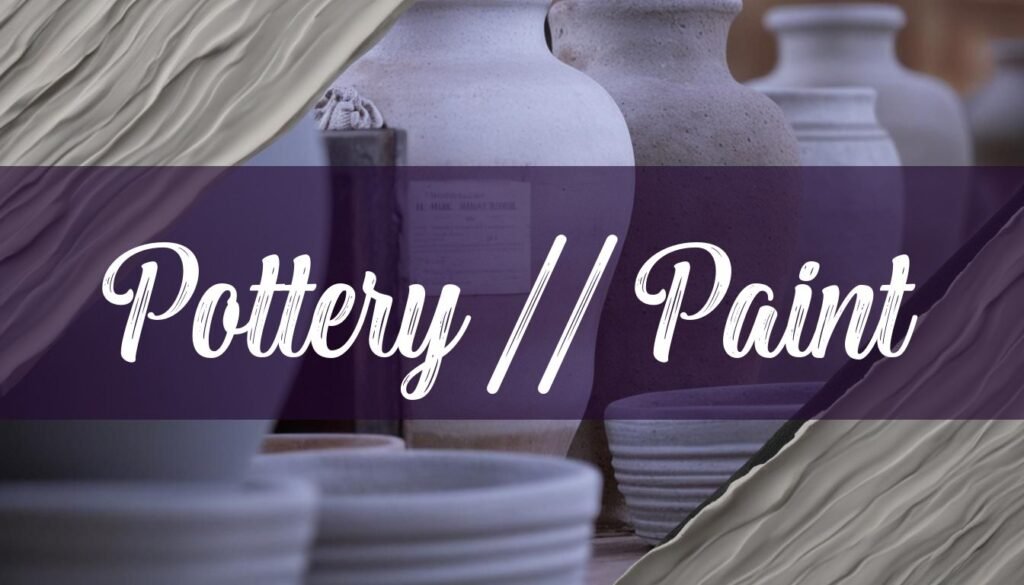When embarking on the delightful journey of pottery painting, the possibilities of what you can paint are as boundless as your imagination. Whether you’re drawn to intricate geometric patterns, the serene beauty of landscapes, or the personal touch of monograms, pottery offers a unique canvas for artistic expression. To ensure your creations stand the test of time, understanding the right techniques, paints, and sealants is key. For those interested in learning more about historical pottery traditions, there’s a wealth of knowledge to explore such as Native American pottery.
Choosing the Right Paints and Preparation
Selecting the appropriate type of paint is crucial for achieving the desired aesthetic and durability on your pottery. For unglazed pottery, acrylic paints are often the go-to choice, celebrated for their versatility and ease of use. These paints are known for being bright, non-toxic (in most brands), and quick-drying, making them perfect for beginners and seasoned artists alike. However, acrylic paint isn’t ideal for glazed ceramics or pieces intended for high-temperature firing in a kiln, as it cannot withstand the heat.
For glazed surfaces, porcelain paint is an excellent choice, as it adheres better to the slick surface. Enamel paints are also a durable option for glazed pottery, offering a glossy finish and resistance to high temperatures when baked. Some ceramic paints, like those from Decola, are specifically designed for ceramics and glass, providing vibrant, pigment-dense colors that become waterproof and even dishwasher-safe after baking.
Before applying any paint, surface preparation is key. For glazed ceramics, sanding down the piece can help remove some of the old glaze, allowing for better adhesion of the new paint. A primer layer can further improve the bond between the paint and the ceramic surface. Regardless of the paint type, ensure the surface is clean and dry before beginning your artistic endeavor.
Design Ideas and Techniques
The world of pottery painting is rich with design possibilities, catering to all skill levels and aesthetic preferences. For beginners, simple yet effective techniques can yield stunning results. Geometric patterns, such as stripes and polka dots, are easy to execute and offer a modern, clean look. Floral designs are another popular choice, allowing for freedom in color, intricacy, and placement, making them an ideal starting point for new painters. Abstract designs offer another avenue for creative exploration, allowing for bold color combinations and free-flowing forms.
For those looking to add a personal touch, monograms or inspirational phrases can be carefully painted onto mugs or plates, using a pencil to sketch the design before tracing over it with paint. Landscape scenes, whether simple or detailed, can transform a plain piece of pottery into a work of art, capturing the beauty of the natural world on a ceramic canvas.
Various techniques can enhance your designs. Sponging is great for creating dimensional designs and textured patterns with depth, giving a rustic, weathered feel. Ombré effects, achieved by blending one color into another, add a lovely gradient to any pottery item. Splattering paint with a firm brush or toothbrush can create bold, layered effects. Stencils and painter’s tape can also be employed to create straight lines and intricate designs.
The firing process is crucial for achieving the right finish. Check out this video of an Amaco glaze kiln opening for inspiration!
Firing and Sealing for Longevity
The firing process plays a crucial role in the durability and appearance of your painted pottery. When potters apply colorful effects to their clay pieces, they often use ceramic materials like underglazes, slips, and oxide stains rather than traditional paints. These materials fuse to the clay body when fired, making them less likely to wear or flake off. The temperature at which pottery is fired varies depending on the type of clay and the desired effect. Low-fire pottery, typically fired between 1,700°F to 2,100°F (Cone 04-06), results in more colorful and bright glazes. Mid-range pottery is fired at intermediate temperatures, while high-fire pottery, fired at temperatures ranging from 2,300°F to 2,700°F (Cone 9-10), produces extremely strong and vitrified pieces, ideal for functional items.
If firing your pottery isn’t an option, sealing becomes even more critical. Sealing not only protects the paint from chipping and fading but can also make your ceramic piece waterproof or food-safe, depending on the sealant used. Options include ceramic glaze for a glossy, durable finish, dishwasher-safe Mod Podge for items you plan to wash in the dishwasher, and acrylic sealer sprays for a quick and easy sealing process. Apply the sealant in a well-ventilated area, using even strokes to cover the entire painted area. Some sealants may require baking in an oven to cure, so always read the instructions carefully.
Safety First
When painting and firing pottery, safety should always be a top priority. Inhalation of clay materials, especially silica, can damage your lungs, so it’s essential to avoid excessive dust exposure and wear a HEPA filter mask when mixing clay or cleaning the studio. Many glaze materials are hazardous, so know what you are using and take precautions to prevent ingestion, inhalation, and skin contact.
Kilns can produce carbon monoxide, formaldehyde, and sulphur dioxide gases, so ensure proper ventilation and wear welders goggles when looking into kiln spy holes to protect your eyes from infrared radiation. Always clean your work area thoroughly after each session and wash your hands well before eating or drinking. For more information on kiln safety, consider reading about kiln care and maintenance.
With the right knowledge, tools, and precautions, painting pottery can be a safe, enjoyable, and deeply rewarding creative outlet. Whether you’re a beginner or an experienced artist, the possibilities for transforming a simple piece of pottery into a personalized masterpiece are endless.





